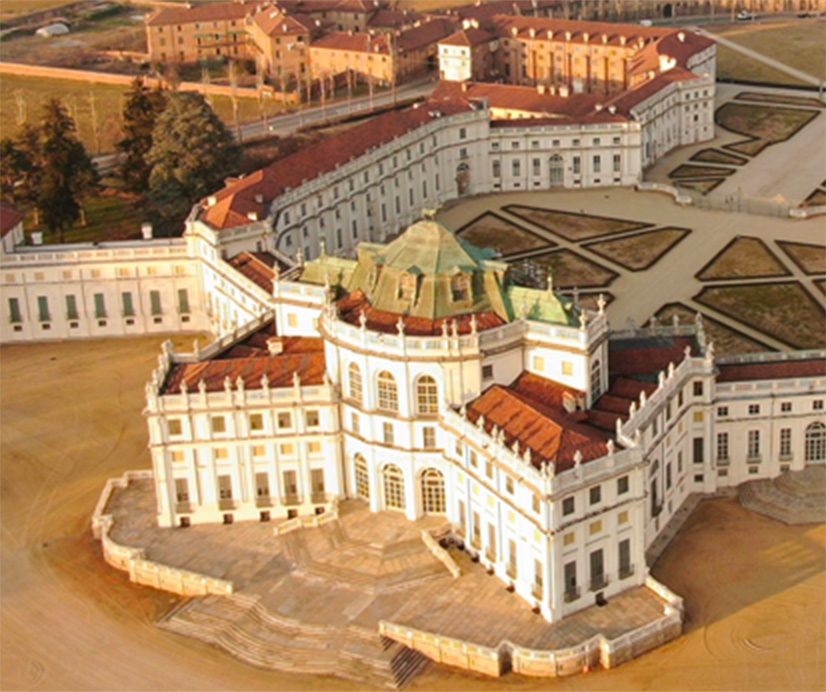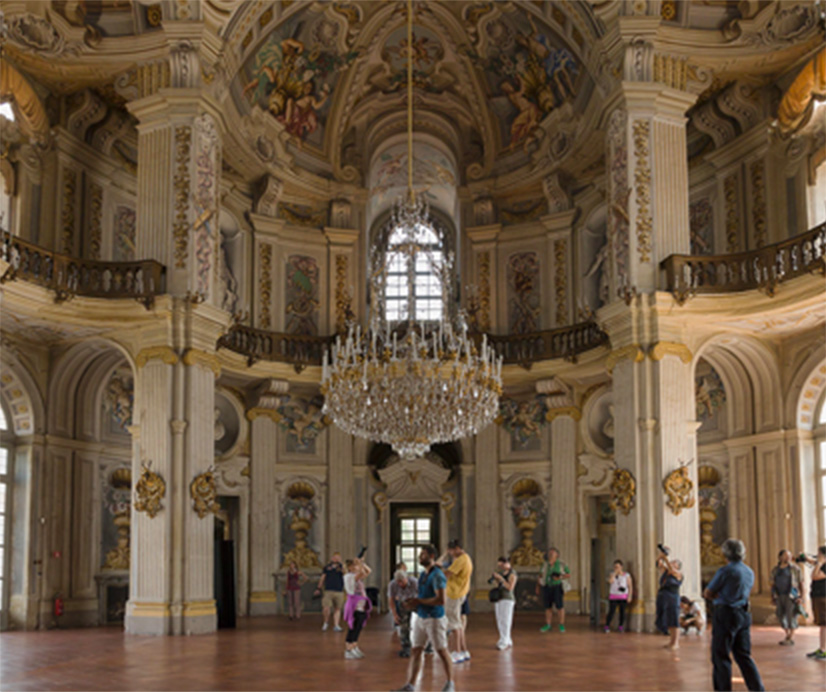History of the Palazzina di Caccia di Stupinigi

Stupinigi is located in Nichelino, only 10 kilometers from Turin, and is one of Piedmont’s most prestigious Savoy Residences. The construction of the building, designed for hunting parties and royal family celebrations, started in 1729 on a project by Filippo Juvarra, one of the most renowned architects of the 18th century.
With over 31,000 sqm and other 150,000 sqm of park and green areas, the Residence represented the Savoy Family’s point of departure and arrival for hunting trips, to the surrounding countryside, and their favorite venue for parties and leisure.
Its construction and expansion continued throughout the 18th century under the guidance of Benedetto Alfieri and other architects.
The Palazzina, despite being a prestigious Hunting Lodge, hosted aristocratic weddings of sovereigns and notables such as Maria Teresa of Savoy with Count Carlo Filippo d’Artois, later crowned king of France as Charles X, then Vittorio Emanuele II with Maria Adelaide of Habsburg Lorraine, before he became the first king of Italy, as well as the wedding of Amedeo of Savoy with Maria Vittoria Dal Pozzo della Cisterna.
Paul I Tsar of Russia, Ferdinand I of Bourbon King of Naples, Napoleon, Pauline Bonaparte, and the Queen of Italy Margherita of Savoy have also enjoyed its elegant rooms.
Starting from the 19th century, after the era of great hunting trips, Stupinigi also became a tremendous zoological garden with exotic animals, ostriches, kangaroos, and, above all, Fritz, an elephant donated to King Carlo Felice by the ruler of Egypt. In 1919, the halls of the Lodge hosted the Museum of Furniture until, during the 20th century, it became one of the major tourist attractions in the Turin area.
The Palazzina di Caccia di Stupinigi also preserves historic windows, doors, and windowpanes among its original furnishings. The blooming phenomenon on the glass panes is irreversible but constantly monitored by the restorers, who conduct weekly conservation activities in each room.
In 1997, it was awarded a UNESCO World Heritage Site title.

Stupinigi Architecture
Filippo Juvarra’s attention to detail in the project has made Stupinigi, with its Palazzina di Caccia, one of the most evocative places in the Turin area. The heart of the complex is represented by the large double-height oval Central Hall, with an incredible upside-down boat dome – dominated, on the outside, by the sculpture of the Deer, the symbol of Stupinigi – and the splendid trompe l’oeil hunting frescoes made between 1731 and 1733 by Domenico and Giuseppe Valeriani. The four arms that give the Palazzina the shape of a St. Andrea Cross start from this hall, with the two apartments of the king and queen and the rooms for the guests. In the residence, there are 137 rooms and 17 galleries in total.
The Planimetry of the Palazzina
The Palazzina di Caccia di Stupinigi is a triumph of Italian Rococò style, with gilded lacquer and stucco, precious furnishing elements, great works of Bonzanigo, the favorite sculptor of the Savoyard court, and the woodwork of Pietro Piffetti, one of the greater cabinetmakers at the time.
The public visit starts from the Scuderia Juvarriana (the stable) with its gallery of the Savoy family portraits and, above all, the original sculpture of the deer in bronze, copper, and gold leaf, created in 1766 by Francesco Ladatte. After a passage through the library and the anti-library, the tour arrives at the Central Hall to continue in the apartments of the king and queen and the chapel of Sant’ Uberto.
The last stop of the visit inside the Palazzina is at the East apartment. Explore the museum itinerary and the Palazzina di Caccia di Stupinigi interiors.
Click on the image to see the map >>>
Napoleon’s Carriage
The Carriage is a significant historical proof of the Napoleonic presence in Italy.
The gala berlin, a trendy type of carriage of the early 19th century, was made in 1805 by the famous Parisian coachbuilder Jean-Ernest-Auguste Getting, one of the leading suppliers to Napoleon’s Imperial Stables.
Richly decorated and finished, the berlin was used for gala parades and city outings.
The carriage, which features the Napoleonic coat of arms on the doors, was probably in the parade that took Napoleon to Milan in 1805 for his coronation as King of Italy, with an initial stop in Stupinigi, where he was hosted with his wife, Giuseppina.
The berlin then passed to his second wife Maria Luigia of Austria, Duchess of Parma, Piacenza and Guastalla from 1816, as attested by the coat of arms that replaces the original Napoleonic insignia.
In 1845, Antonio Delavo, a pharmacist passionate about Napoleonic history, purchased the carriage and included it in the museum dedicated to the Battle of Marengo set up in his villa.
When the residence was sold in 1947, the Berlin passed to the antique dealer Edilio Cavanna, who preserved it in the warehouse without particular attention.
In 1953, the famous mentalist Gustavo Adolfo Rol decided to buy the carriage and restore it in Turin. On June 3, 1955, the carriage arrived at the Palazzina di Caccia di Stupinigi to be exhibited.

Virtual tour of the Palazzina
Upcoming events at the Palazzina
Exhibitions, cultural events, and guided tours at the beautiful Palazzina di Caccia di Stupinigi. Do not miss our updates on the following events.
Download the Stupinigi audio guide
Explore the Stupinigi Hunting Lodge in an incredible digital itinerary on your smartphone. 26 points of interest to discover through a 65-minute audio tour that will allow you to learn every secret of the Palazzina.

Info and Contacts
Piazza Principe Amedeo, 7
10042 Stupinigi – Nichelino (TO)
tel. +39 011 6200601
stupinigi@biglietteria.ordinemauriziano.it
